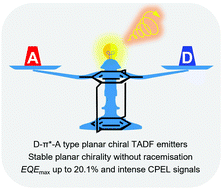D–π*–A type planar chiral TADF materials for efficient circularly polarized electroluminescence†
Abstract
Planar chiral organic fluorescent materials that exhibit high chiral stability, high efficiency and circularly polarized luminescence (CPL) currently remain an unresolved issue despite their promising applications in optical encryption and 3D-display. Herein, a pair of new donor-chiral π-acceptor (D–π*–A) type planar chiral thermally activated delayed fluorescence (TADF) enantiomers, namely R/S-PXZ-PT, are developed. Such a D–π*–A type structure completely suppresses the racemisation of the planar chirality, making it possible to prepare circularly polarized organic light-emitting diodes (CP-OLEDs) by vacuum deposition processing. Moreover, this design perfectly integrates the chiral unit into the luminescent unit to achieve intense CPL activity with luminescence asymmetry factors (glum) of ±1.9 × 10−3. Notably, the enantiomer-based devices exhibit a yellow coloured emission with a maximum external quantum efficiency (EQE) of 20.1%, and mirror-image circularly polarized electroluminescence signals with electroluminescence dissymmetry factors (gEL) of +1.5 × 10−3/−1.3 × 10−3. This work not only enriches the diversity of chiral TADF molecular design, but also provides a new perspective for the development of highly-efficient CP-OLEDs with stable planar chiral TADF materials.

- This article is part of the themed collections: Editor’s Choice collection: Chiral Functional Materials, Materials Horizons Lunar New Year collection 2022 and 2021 Materials Horizons most popular articles


 Please wait while we load your content...
Please wait while we load your content...